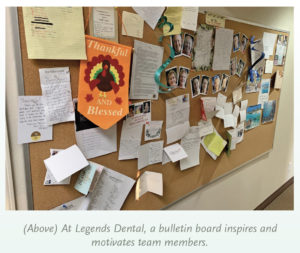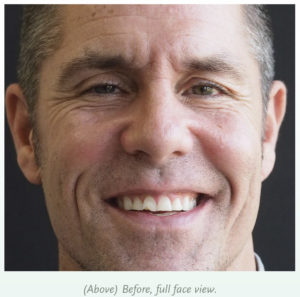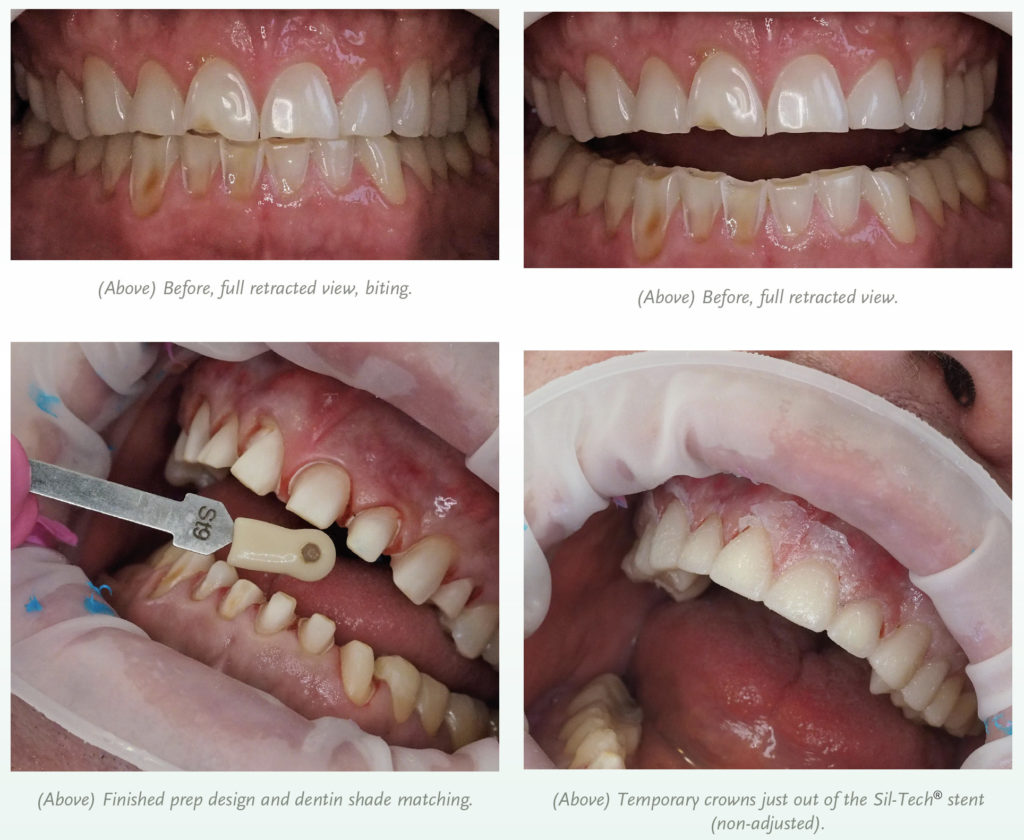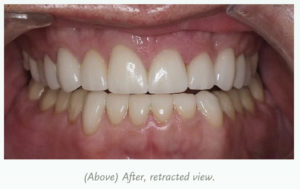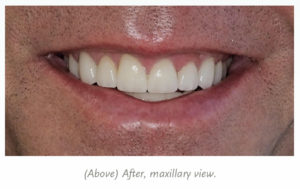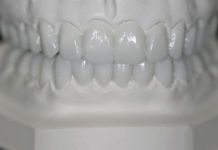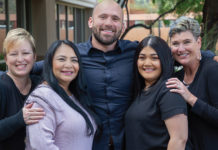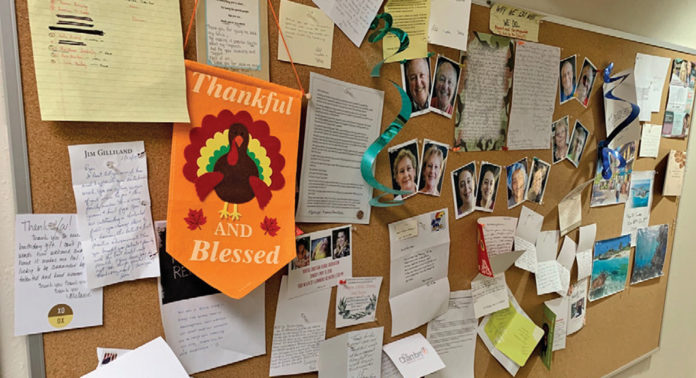
Most people who choose a medical profession as a career do so because they are drawn to the idea of helping people. In my case, I wanted to help people with their oral health. The longer I work in this industry, and the more I learn, the more it seems I still need to learn. Learning opens my eyes to all the possibilities.
When I graduated from dental school, my practice was limited to doing basic fillings and the general standards of care. Today, diagnosing a full arch or full mouth rehabilitation case is a fairly routine experience. It’s part of my journey. My goal in practicing dentistry now is to change someone’s life, not just improve his or her mouth.
Patients often visit my practice and say, “I feel like my smile doesn’t fit who I am anymore.” I quickly notice that their teeth are worn away or sometimes even missing, and it changes their appearance and, more importantly, the way they feel about themselves.
Our society has always made judgments based on appearance, and it’s more prevalent than ever with social media. Patients with less than optimal dentition can develop a psychological barrier because of their smiles. They can become self-conscious and often don’t experience life to its fullest.
As a dentist, I can help to remedy the problem of missing or worn dentition. Helping someone with this issue can change a patient’s self-esteem, and from there, that patient has the confidence to advance towards greater opportunities and experiences.
Dentistry is what opens up an individual’s possibilities. As dentists, our mission is to give people hope in their current circumstances. Everyone deserves a chance to change their pattern and life path.
In my practice, we talk about this mission a lot. We have a bulletin board in the back room that’s just for our team where we place photographs and thank-you notes from some of our cases. At the end of the year, we remove everything from the board and start the new year with a clean slate. By year’s end, it’s covered with images and notes from patients who want to express their appreciation for our efforts.
We don’t show the bulletin board to the patients, but my team members pass by it as they enter or leave the building. It is a constant reminder of what we do and why we do it.
If a team member is having a bad day, I ask them to look at the board and read what people have said about our work. It reminds us how important our daily tasks are and what they mean to our patients.
When team members get excited about what they are doing, it connects with patients on a deeper level. At that point, it’s not about cost anymore. For the patient, it becomes, “How do I make this fit into my life?” Once that perspective has changed, patients don’t view dental care as an expense. They see it as an investment in themselves.
With every new patient, we try to understand his or her personal story. Once we understand it, we can figure out how to give the patient hope. If we don’t do that, or if we rush through the process, it never works well, and the patients aren’t satisfied.
If dentists establish a caring, hopeful culture in the dental practice, however, it’s no longer about selling dentistry. It’s about improving patients’ lives. And that’s much more fun than drilling and filling holes all day long.
A February Day
In the Full Arch Reconstruction (FAR) course with the Dr. Dick Barnes Group (DDBG) in Salt Lake City, UT, dentists learn that they should do their first full arch case on a day when no one else is in the office. That way, they can focus on the protocols and the procedures that were taught with no distractions. After performing this procedure numerous times, I can now work such cases into the normal workday, because I know all the steps and protocols so well.
Recently, we did a case in which the patient wanted treatment because of the photos he saw displayed on the walls of our practice. Such cases sell themselves once patients realize what’s possible and dentists educate them about how it can be done. This particular case did not require the patient’s whole mouth to be rebuilt because his problems were mainly in the anterior aesthetic areas.
I had known this patient for years, and he viewed his case primarily as an aesthetic one. However, I viewed his case as a functional one because of the way he had abused his teeth. From my perspective, the aesthetics were a secondary benefit. The functional issues stemmed from attrition and erosion due to a history of chewing tobacco for about 30 years.
In addition, the patient was a bruxer, and he had flattened his front teeth. Nonetheless, his vertical in the posterior was still within the Shimbashi rules of normal (16–21 mm), and he was asymptomatic in his joints and ligaments.
He is a good-looking guy, but his teeth didn’t match his appearance and great personality. Fixing his teeth made an impressive and noticeable difference. His was not a basic procedure. It was a very advanced one, and some dentists might not have diagnosed it because there was no decay and the patient had no symptoms. This case would have been overwhelming to me 18 years ago. But on the day we did the treatment, it was fun—exhilarating even.
It was a cold Friday morning in February, and my dental assistant, Jenny, and I were the only ones working because the office was closed. The sun was shining, the phones weren’t ringing, and the music playing through the speakers was perfect because I chose it. It was an ideal day to do dentistry.
We did the patient’s uppers and lowers on the same day. Using the White Wax-Up from Arrowhead Dental Laboratory, we started treatment: 14 units total, 8 on the uppers, 6 on the lowers. It was so energizing to whip out 14 crown preps like it was nothing.
While I was working, it occurred to me that a case like this was once a super stressful, difficult thing. And yet we did the prep appointment in about two-and-a-half hours. Everything went smoothly. The temporaries went right in, and they looked great. He was happy. We were happy. That’s when it hit me how far I had come.
A Steady Progression
I started my practice, Legends Dental, in Lawrence, KS, immediately after dental school. At the time, I worked in my practice only twice a week, and on the other days I worked in different practices, so I had at least some guaranteed income.
One day, I came across a wax-up sitting on the counter in one of those offices, and I was blown away. Until then, every wax-up I had seen was on yellow stone and the teeth were either blue or green wax. But this thing was beautiful! It was on polished ortho stone and even the teeth were white! I’m kind of a dental geek, and it was the coolest thing I had ever seen. I decided to find out who had done the wax-up, and that was my introduction to Arrowhead Dental Lab about 18 years ago.
As a young dentist at the time, all I knew was what I had learned in dental school, which, looking back, wasn’t much more than the basics. I have to give props to my alma mater, Creighton University in Omaha, NE. They taught me the basics well. From then on, however, I was on my own—my own gumption, and my own dime. I eventually learned a few key principles that helped me get where I am today.
Here’s what I learned:
-
Invest in continuing education (CE).
Early on, I jumped into taking CE courses with the DDBG, and everything I learned there built on what I had learned in dental school. I fell in love with that way of learning. I returned home from CE courses with renewed excitement, motivated to take more and more courses. I started trying to take at least two big courses a year, and I have done that for 18 years.
Today, I attend CE courses all over the country, and I have even started to look at some courses in other countries. As I keep learning, I discover how much I still don’t know.
CE has helped me build my practice from a general practice to one that does full arch and full mouth rehabilitations, extractions, bone graftings, implant placements, and immediate load surgery. In 2019, I did almost 60 arches of fixed full arch implant prostheses. It’s a different practice than I ever imagined when I graduated from dental school.
My patients have also motivated me to keep learning. Several times, patients have visited our practice and asked whether I could do a procedure that they had read about. If I say that I don’t know it, they tell me to go and learn it, and they will wait until I can do it. When I went to my first implant course, I had about 20 patients waiting for me to do an implant on them, which was an amazing feeling of acceptance and confidence in my work and philosophy.
-
Involve your team members.
After taking CE courses on my own, I soon realized that I needed my team members to learn as much as I did. I could learn the parts that involved me as the doctor, but when I came back to the office, I didn’t always remember what the assistant was supposed to be doing.
When they attended the courses with me, they could watch and learn their parts. Then when we returned to the office together, it was much easier to implement the new skills.
Change isn’t easy. Adding new skills and procedures isn’t easy. It’s particularly hard on hygienists because they have to understand how to explain the new procedure to patients in such a way that it sounds attractive to them. When the doctor is the only one who can explain it, it’s pretty tough to work that conversation into a hygiene visit—especially when you have only a couple of minutes and three patients waiting.
I suppose every doctor has gone to a CE course, learned something amazing, and returned to his or her practice anxious to implement the new ideas. But it only takes about 10 minutes at the office before reality sets in—a patient is late for a restorative appointment, an emergency gets added to the schedule, the hygienist is pacing in the hallway—and it’s easy for a dentist to get caught up in these things and never get around to teaching the team what he or she just learned. It can make CE courses feel like a waste of time, energy, and money.
-
Create your own opportunities.
I discovered that if I wanted to implement a new skill, I had to create my own opportunities. If I learned about a new procedure and knew that a patient could benefit from it, I would schedule a meeting with my team soon after I returned from the course. If I wasn’t intentional, I could easily brush aside what I had learned and keep going in the same direction as before.
The Future
At this stage in my career, my goal is to find an associate and bring him or her on board for training in a true apprenticeship situation. My plan is for the associate to master general dentistry, and then move on to advanced cases. That way, I can focus on doing more of the surgical procedures and the implants that I have learned to love.
To my colleagues in the dental industry, we should be proud we are in a profession that gives us enough latitude to experience more than we were originally taught. The thing no one can replicate is you. Be the best version of yourself possible. You don’t have to be perfect, but you should be progressing. Yes, it requires stepping outside of your comfort zone. It requires discipline, hard work, and passion for the profession. But it also requires balance in order to have a life, a family, and a successful business.
Don’t settle for replicating what you did last year, or even over the last 10 years. Turn your challenges into opportunities. Look for the things you love about dentistry and do just those. Do them to the best of your ability, and when you look back at the end of 2020 you’ll be amazed at how far you’ve come. To quote the great Tawana Coleman, the “queen” of Total Team Training seminars, “the best is yet to come.”
I’ve been doing dentistry for 18 years, but in some ways it feels like I just started. What used to be extremely advanced seems basic to me now. It’s a progression that I wish for every dentist who wants to improve the lives of his or her patients. I can’t wait to see what’s next.

